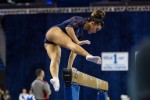During a season, an extended break between competitions is necessary.
For No. 6 UCLA gymnastics, the two-week layoff between Sunday’s meet against No. 1 Oklahoma and their upcoming meet against Oregon State comes at a time when team members need to get healthy and add new elements to their routines.
The Bruins’ score improved by just over a point from their first meet against Arkansas to last weekend’s meet against Oklahoma.
Coach Valorie Kondos Field said the Bruins should be scoring in the mid-197 range and sees correcting the little deficiencies in key events as the way to get there.
[Related: Gymnastics stays positive despite loss to Oklahoma]
“They are so confident on balance beam. They’re like machines up there,” Kondos Field said. “The people competing on vault, bars and floor are every bit as talented and seasoned and prepared. I think they’re allowing themselves to lower their standards on those events.”
UCLA now has two weeks to implement improvements.
The break also allows injured gymnasts like sophomore Madison Preston, who was seen with a walking boot on her left leg, and freshman Felicia Hano to recover without missing an important meet.
“These two weeks will be important for getting everyone healthy, but also to put in our bigger skills that we have ready to put in,” said junior Sonya Meraz.
Mistakes like freshman Kyla Ross’ lower start value on balance beam or having to count a fall on floor exercise in both meets this season are avoidable.
Putting time into working on the collective routines can alleviate and minimize the possibility of them recurring.
[Related: No. 4 UCLA gymnastics relies on freshmen in victory over Arkansas]
The injured Preston’s 9.900 on vault and 9.875 on floor in her only performances this season have her lined up to be a major contributor for the Bruins.
“I don’t think we need the two weeks, but we are definitely benefitting from it,” said senior Peng-Peng Lee. “We are very much planning these next two weeks so that we can gain from them.”
While the focus is on raising the overall difficulty and execution in the team’s collective routines in training, the goal is to make sure that the improvements show up during actual competition.
“The next meet, when we go away, hopefully we are able to perform those more difficult skills to better execute them,” Lee said.
